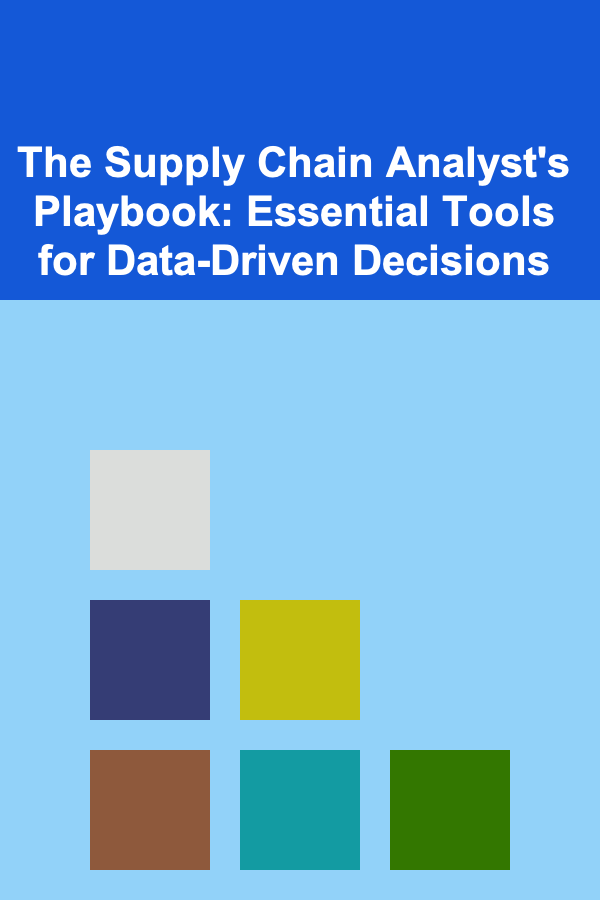
The Supply Chain Analyst's Playbook: Essential Tools for Data-Driven Decisions
ebook include PDF & Audio bundle (Micro Guide)
$12.99$8.99
Limited Time Offer! Order within the next:

In the fast-paced world of supply chain management, data has become the lifeblood of decision-making. The role of the supply chain analyst is increasingly reliant on their ability to harness and interpret data to drive efficiency, reduce costs, and enhance overall performance. As the complexity of global supply chains continues to grow, leveraging the right tools for data analysis has never been more critical. In this guide, we explore the essential tools that every supply chain analyst should have in their playbook to make data-driven decisions that positively impact the business.
The Importance of Data in Supply Chain Management
Data-driven decision-making is at the core of modern supply chain operations. The ability to make informed decisions based on accurate and timely data allows supply chain analysts to:
- Forecast demand with precision,
- Optimize inventory management,
- Improve supplier relationships,
- Enhance logistics efficiency, and
- Mitigate risks.
Without the right tools and methodologies, analysts may struggle to turn raw data into actionable insights. The sheer volume of data generated by modern supply chains---from sales data, inventory levels, transportation routes, to supplier performance---can overwhelm analysts. Thus, it's essential to utilize tools that can process, analyze, and visualize this data effectively.
Essential Tools for Data-Driven Decisions
1. Data Analytics Software
Data analytics software forms the backbone of any data-driven supply chain operation. These tools allow supply chain analysts to process large datasets, identify trends, and make predictions.
Key Tools:
- Microsoft Power BI: Power BI is a powerful tool for creating interactive dashboards and reports. It helps analysts transform complex data into visually intuitive insights, making it easier to identify patterns in real-time data.
- Tableau: Tableau is another widely used tool for visualizing data. It offers advanced data analytics and visualization capabilities, allowing analysts to dive deep into supply chain data and explore various metrics with ease. Tableau's drag-and-drop interface makes it accessible to analysts, even those without a technical background.
- QlikView/Qlik Sense: Qlik's associative data model enables analysts to combine data from various sources and explore relationships between different data points. Qlik's in-memory analytics engine provides rapid processing of large datasets, which is particularly useful for supply chain analysis.
Actionable Strategies:
- Use Power BI or Tableau to create live dashboards that track key performance indicators (KPIs) such as inventory turnover, on-time deliveries, and supplier performance. This will allow you to monitor your supply chain in real time and make timely adjustments when necessary.
- Leverage the predictive capabilities of Tableau and Qlik to forecast demand, identify potential bottlenecks, and optimize production schedules.
2. Forecasting Tools
Accurate demand forecasting is crucial for effective supply chain management. Supply chain analysts use forecasting tools to predict customer demand, ensuring that businesses can align their inventory, production, and logistics strategies accordingly.
Key Tools:
- SAP Integrated Business Planning (IBP): SAP IBP is a robust platform that combines demand planning, inventory optimization, and sales and operations planning (S&OP). It helps businesses forecast demand accurately and align it with production capabilities.
- Oracle Demand Management Cloud: This tool uses machine learning algorithms to predict customer demand based on historical data, sales trends, and external factors. It provides supply chain analysts with advanced insights into demand fluctuations.
- R and Python (Libraries: Prophet, Statsmodels): For analysts who are comfortable with coding, R and Python offer extensive libraries for time-series forecasting. Tools like Prophet (by Facebook) and Statsmodels in Python allow analysts to apply advanced statistical models to forecast demand.
Actionable Strategies:
- Integrate SAP IBP or Oracle Demand Management Cloud into your supply chain processes to create more accurate demand forecasts. This will help reduce stockouts and overstock situations, optimizing inventory levels and minimizing carrying costs.
- For more advanced forecasting, use Python or R to build custom models using machine learning techniques like ARIMA, XGBoost, or neural networks. These models can better capture complex patterns in demand and provide more accurate predictions.
3. Supply Chain Management Platforms
Supply chain management (SCM) platforms offer a comprehensive view of the entire supply chain network. These platforms connect various supply chain functions, such as procurement, production, logistics, and distribution, enabling analysts to optimize each stage.
Key Tools:
- SAP Supply Chain Management (SCM): SAP SCM is an integrated solution that helps businesses plan, execute, and monitor supply chain processes. With modules for inventory management, order fulfillment, and supplier collaboration, it provides analysts with a centralized platform for managing the entire supply chain.
- Oracle SCM Cloud: Oracle's SCM Cloud solution provides end-to-end visibility across the supply chain. It offers features such as real-time monitoring, advanced analytics, and the ability to manage suppliers, inventory, and logistics on a single platform.
- Kinaxis RapidResponse: This tool focuses on demand and supply planning, offering real-time visibility and the ability to respond to changes in demand or supply disruptions. It helps analysts quickly adjust plans and improve supply chain agility.
Actionable Strategies:
- Implement SAP SCM or Oracle SCM Cloud to centralize supply chain data, enabling better coordination and decision-making across departments.
- Use Kinaxis RapidResponse's "what-if" simulation capabilities to evaluate different supply chain scenarios and prepare for disruptions, such as unexpected demand spikes or supplier delays.
4. Inventory Optimization Tools
Effective inventory management is critical for reducing costs while maintaining service levels. Inventory optimization tools help supply chain analysts balance stock levels to avoid both stockouts and excess inventory.
Key Tools:
- NetSuite ERP: NetSuite's inventory management features enable analysts to track inventory in real time, optimize stock levels, and forecast future inventory requirements based on historical demand data.
- E2open Inventory Optimization: E2open provides a cloud-based inventory optimization tool that uses advanced algorithms to ensure that businesses carry the right amount of inventory at the right time. It integrates demand forecasts and supply chain constraints to optimize stock levels.
- Llamasoft (now part of Coupa): Llamasoft's AI-driven supply chain analytics platform provides advanced inventory optimization, allowing analysts to reduce excess stock and streamline inventory processes across global supply chains.
Actionable Strategies:
- Integrate NetSuite ERP or E2open Inventory Optimization into your supply chain process to improve inventory visibility and reduce carrying costs. These tools will also help reduce the risk of stockouts and better align inventory levels with customer demand.
- Use Llamasoft's advanced algorithms to develop inventory policies that account for supply chain variability, ensuring that you maintain optimal stock levels even in fluctuating markets.
5. Transportation and Logistics Tools
Transportation and logistics play a pivotal role in ensuring the timely delivery of goods. By optimizing transportation routes and warehouse operations, supply chain analysts can reduce costs and improve customer satisfaction.
Key Tools:
- Transplace: Transplace is a transportation management system (TMS) that helps analysts optimize shipping routes, manage carriers, and reduce transportation costs. Its real-time visibility allows for proactive management of delays and disruptions.
- Manhattan Associates TMS: This platform focuses on both transportation and warehouse management. It offers route optimization, real-time shipment tracking, and warehouse automation features to improve logistics efficiency.
- Geographic Information Systems (GIS) (ArcGIS): GIS tools like ArcGIS allow analysts to visualize and optimize transportation routes by analyzing geographical data. GIS tools can be used to model optimal delivery routes, factoring in traffic, road conditions, and geographical constraints.
Actionable Strategies:
- Use Transplace or Manhattan Associates TMS to optimize your transportation routes and minimize shipping delays. These tools can help you cut fuel costs, improve on-time deliveries, and enhance overall logistics efficiency.
- Utilize ArcGIS to assess geographical data and model the most cost-effective delivery routes. This is especially useful for businesses with complex or international supply chains.
6. Risk Management and Simulation Tools
Supply chain disruptions can arise from various factors, such as natural disasters, political instability, or supplier bankruptcies. Risk management tools allow supply chain analysts to assess potential risks and develop contingency plans.
Key Tools:
- RiskMethods: RiskMethods is a risk management platform that provides visibility into potential supply chain disruptions. It uses data from multiple sources to identify risks and offers tools for mitigation and response planning.
- Simul8: Simul8 is a simulation software that allows analysts to model supply chain processes and test different risk scenarios. This helps businesses prepare for disruptions by simulating the impact of various risks on supply chain performance.
Actionable Strategies:
- Implement RiskMethods to gain insights into potential supply chain risks and develop early-warning systems that can help mitigate disruptions before they escalate.
- Use Simul8 to model different risk scenarios, such as a supplier failing to deliver on time or transportation routes being blocked, allowing you to test responses and develop robust contingency plans.
Conclusion: Building a Data-Driven Supply Chain
As the complexity of global supply chains grows, so too does the importance of data-driven decision-making. The tools outlined in this playbook empower supply chain analysts to gather, analyze, and act on data to optimize every aspect of the supply chain. By leveraging these tools, analysts can forecast demand, optimize inventory, improve supplier relationships, and enhance logistics operations.
In a world that is increasingly interconnected and subject to rapid changes, supply chain analysts must continually adapt, learn, and innovate. Using the right combination of data analytics, forecasting, inventory optimization, logistics, and risk management tools, analysts can not only ensure the smooth flow of goods but also contribute to the overall strategic goals of the organization. With the right tools in their playbook, supply chain analysts can drive greater operational efficiency, reduce costs, and achieve sustainable growth.

How to Allocate Time for Learning and Growth
Read More
How to Arrange Your Sewing Machines for Maximum Efficiency
Read More
How to Build a Solid Financial Foundation in Your 40s
Read More
How to Manage Inventory for Your Online Store with Limited Time: An Actionable Guide
Read More
How to Prepare Your Home for Extreme Weather Conditions
Read More
How to Provide Language Learning Instruction to Children: An Actionable Guide
Read MoreOther Products

How to Allocate Time for Learning and Growth
Read More
How to Arrange Your Sewing Machines for Maximum Efficiency
Read More
How to Build a Solid Financial Foundation in Your 40s
Read More
How to Manage Inventory for Your Online Store with Limited Time: An Actionable Guide
Read More
How to Prepare Your Home for Extreme Weather Conditions
Read More